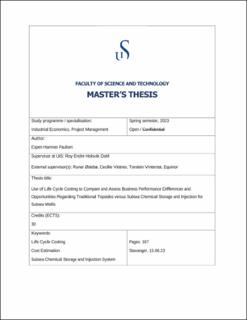| dc.description.abstract | As a significant aspect of sustainable development, Equinor is currently engaged in a substantial technology advancement involving subsea all-electric (AE) functions as a replacement for the conventional topside electro-hydraulic (EH) functions. Within the AE function, subsea infrastructure developers are planning and developing a Subsea Chemical Storage and Injection System (SCSIS) on the seafloor infrastructure. The system consists of storage units for chemical products located on the seafloor, connected to the manifold for onwards distribution. It serves as an alternative to the conventional distribution system where chemical products are stored in storage tanks on the topsides facility (e.g. fixed or floating platform) and injected into the subsea production system via an umbilical.
The primary objective of this thesis was to conduct an evaluation of the business performance differences between the EH function and the AE function within the domain of chemical injection, over a 20-year design life. To achieve this objective, the thesis employed the life cycle costing methodology as presented in ISO 15663:2021. The methodology served as a comprehensive tool for comparing the life cycle costs of two alternative options. By identifying cost elements and cost drivers for each of the options associated with the main elements of life cycle costing, namely CAPEX, OPEX, and LOSTREV, the life cycle costing methodology could be utilized. Furthermore, by employing a diverse range of economic evaluation measures, coupled with trade-off considerations in life cycle costing such as HSE and sustainability factors, the thesis study aimed to determine which option offered superior benefits.
The economic evaluation measures encompassed a variety of Monte Carlo simulations implemented within an Excel model to facilitate probabilistic cost estimations for each of the economic evaluation measures. The model was executed utilizing modified Equinor-specific data that aligned with the technical and operational basis outlined in Chapter 2 of the thesis. These modifications ensured that the data employed in the analysis were tailored to meet the specific requirements and standards established in the theoretical framework of the thesis.
The thesis has demonstrated that employing the life cycle costing methodology for a project with a 20-year life cycle yields significant insights that aid in the decision-making process for investments within the petroleum industry. The accuracy of the cost estimations has been substantiated through a comparative analysis conducted on an offshore project of comparable scale, as well as consultation with Equinor representatives. Moreover, the thesis has illustrated that employing a probabilistic estimation methodology, supported by both top-down and bottom-up estimation approaches, can effectively address substantial uncertainties inherent in the life cycle cost analysis, resulting in sound results. | |
